When hostile conditions compromise research protocols: An excerpt from Science in an Extreme Environment
When hostile conditions compromise research protocols: An excerpt from Science in an Extreme Environment
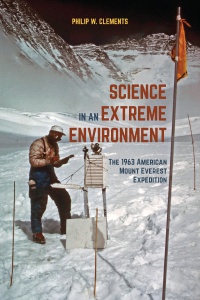

Science in an Extreme Environment by Philip W. Clements, examines the relationship between extreme environment and scientific inquiry, and investigates the expeditions science program for the first time.
Below, we share the introduction from Clements new book:
A frigid gale rose as night fell across Mt. Everest on May 15, 1963. At 7000 meters on the mountain’s steep west shoulder, in the bleak no-man’s-land between camps, research sociologist Richard Emerson climbed alone. Weakened by seven weeks of altitude-induced coughing, vomiting, and diarrhea, he was nevertheless determined to join his test-subjects and friends in the high camps before they departed for the mountain’s summit. But, the wind was rising, and Emerson carried neither a tent for refuge, nor a radio to signal his distress. Not that his companions could have helped him, because the same winds that jeopardized Emerson’s life were at that moment tearing the expedition’s high camps from the mountainside. Out of options, Emerson hunkered down in a glacial crevasse as the storm raged overhead. On that night, science imperiled Emerson’s survival, Emerson’s survival eclipsed science, and the sociologist’s carefully-planned research program threatened to blow away into Tibet.
Emerson’s prospects on Mt. Everest had not looked so grim back on June 9, 1961, when he received a letter from a colleague who suggested that they collaborate to explore “research possibilities on high altitude climbs” that would take place on Mt. Everest in 1963. Emerson, a University of Cincinnati professor and a former mountain guide who had dabbled with sociological research during a climb in Pakistan’s Karakoram Range in 1960, was immediately receptive to the idea. By July 31, 1961, he had secured a place on the 1963 American Mount Everest Expedition (AMEE).
Armed with a new iteration of the methodology he developed for the Karakoram, tailored to Mt. Everest’s immensity, Emerson successfully appealed to the National Science Foundation for funding upon the premise that his research objectives would be valuable to contemporary astronauts and soldiers, and that Mt. Everest’s extreme locale made his mountaineering test-subjects suitable proxies for these groups. Preparing for his research on the mountain, Emerson acquired state-of-the-art, German-made portable tape-recorders, and printed research diaries to be kept by AMEE personnel for the duration of their expedition. He believed that the tape-recorders and diaries would allow for reliable data collection on the mountainside, where freezing temperatures, exhaustion, and the high-altitude ranging of his test-subjects would make normal sociological interviews impossible.
But Mt. Everest did not readily succumb to Emerson’s probes. When AMEE established Base Camp on March 23, 1963, Emerson was already suffering from acute mountain sickness. The mountain’s altitude left him bedridden, its temperatures froze his tape-recorders, and its treacherous terrain killed one of his test-subjects. These misfortunes, combined with other contingencies generated by Mt. Everest’s extreme environment, destabilized and re-shaped his research program. His colleagues’ inquiries were also thwarted by the extreme environment on the Everest massif; upon leaving the mountain, AMEE’s glaciologist reflected, “We came to appreciate the formidable problems facing [scientists] who undertake field research in this hostile physical environment at great altitude, and what must be done to engage effectively in such inquiry where inordinate amounts of time and energy must be spent simply to survive.”[i]
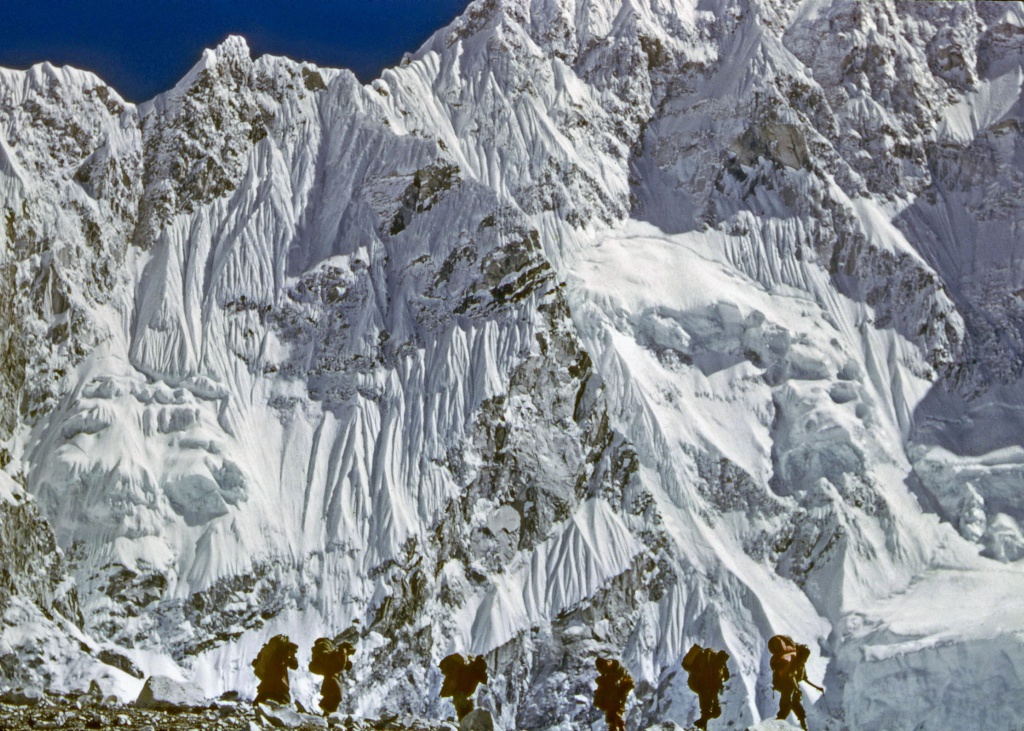

Mt. Everest was a place in which humans could not live without extensive life-support systems. It was unpopulated, had never been populated, and was only ever populated seasonally, and “without the normal complement of a fully functioning society.”[ii] Life only ever existed at the margins of the Everest massif. Rigorous scientific research in such a place would never be simple or straightforward. Emerson and his colleagues traveled halfway around the world at staggering cost to interrogate one of the world’s most extreme environments. But what kind of science were they able produce in their new and unwieldy laboratory? Were their findings as exceptional as the place in which they were created, or could they be generalized to other environments?
Attention to such questions is on the rise. In 2003, historian David N. Livingstone synthesized a body of scholarship representative of the “Spatial Turn” in science studies. Just as 20th-century participants in the “Cultural Turn” made our understanding of scientific practices and beliefs more sophisticated by demonstrating their social and cultural heritage, Livingstone’s collection of late-20th and early-21st century scholars analyzed the relationship between geographical locations and scientific research:
There is something strange about science. Scientific inquiry takes place in highly specialist sites–high-tech labs, remote field stations, museum archives, astronomical observatories. It has also been pursued in coffee shops and cathedrals, in public houses and stock farms, on ships’ decks and exhibition stages. And yet the knowledge that is acquired in these places is taken to have ubiquitous qualities. Scientific findings, to put it another way, are both local and global; they are both particular and universal; they are both provincial and transcendental. To ask what role specific locations have in the making of scientific knowledge and to try to figure out how local experience is transformed into shared generalization is, I believe, to ask fundamentally geographical questions.[iii]
Spatial Turn scholars who asked those geographical questions have shown how those “highly specialist” places functioned as theaters of cultural performance, and how mundane places were transformed into scientific sites. Their analytical slant provoked new questions about the universality of scientific knowledge.[iv] For, if scientific knowledge needs to bear “the marks of nowhere” to be considered universal, then the localized spatial contexts that are integral to generating that knowledge problematize its nowhere-ness.[v] Scholars who specialize in spaces of scientific inquiry interrogate how these spatial contexts affect the production of knowledge, and, in turn, how scientific inquiry affects and defines the spaces in which it is conducted.[vi] They use two terms: place, a geographical, physical location, and space, an immaterial and abstract expanse in which scientific practices occur. It is the relationship between these two concepts that is the stamp of their trade.[vii]
The following narrative uses a particular case in the mid-20th-century to demonstrate the manifold effects of space’s constitutive function in the creation of scientific knowledge. This case was chosen because it took place in an extreme environment, in a time of extreme politics; the political context made sense of AMEE’s quest to glean knowledge in an extreme physical environment. To combine temporal locality with geographical locality, we add locale to the Spatial Turn’s lexicon. Locale emphasizes the presence of historical contingencies within the space of inquiry. Temporal and spatial contexts are both folded into locale, and, as I will demonstrate in the chapters to come, locale plays a causal role in the production of scientific knowledge at every step in its creation. Research questions, hypotheses, methods, observations, and conclusions are all subject to the contingencies of locale.
The extremity of AMEE’s locale, and the practices of its five principal researchers and their handful of assistants and test-subjects, throws into sharp relief the locale’s influence over the production of scientific knowledge. But these influences amounted to more than the sum of the locale’s geographical features. They also included political ideologies and scientific traditions. AMEE’s scientists conducted research for institutions whose extreme ideologies created a gulf between the world’s superpowers and bridged that gulf with extreme policies like New Look, Massive Retaliation, and Mutually Assured Destruction. They willingly ventured to a place at the physiological limits of human adaptation and inhabitation to propel six men to 8,848 meters above sea level, an elevation whose lack of oxygen is at the very limit of human survival, and where objective dangers are so extreme that one AMEE test-subject was killed, and three others were mutilated by frostbite.[viii] AMEE scientists also drew upon centuries-old traditions of scientific practices and environmental imaginaries about mountains as exceptional spaces for inquiry to both create a locale that was attractive to Cold War funding institutions and prepare for a locale that was hostile to scientific research.
Their attempt to construct and prepare for the unique Himalayan environment is also exceptional because it was the first and last time an American multi-disciplinary scientific research program was married with a major mountaineering objective. Its architects hoped that both a mountaineering and scientific success would normalize this partnership for future endeavors. However, neither scientists nor mountaineers have attempted to wed these goals since AMEE returned from the Himalaya in 1963. This raises the question of whether AMEE’s scientific shortcomings extinguished hopes that these two disparate activities could be reconciled, especially since its mountaineering successes remain widely celebrated.[ix] It also highlights the need to closely examine how scientific and mountaineering interests manifested and interacted in both the locale and in AMEE’s post-expeditionary scientific reports. Such an examination can be used to determine whether the current consensus of irreconcilability is warranted.
This matter of interests is just one part of a story about the scientific values and norms that constituted and obstructed AMEE’s scientific practices.[x] Throughout this text, that story is accompanied by an analysis of localism: of constructing an environment for scientific inquiry, transporting inquiry into that environment, and “de-localizing” knowledge produced therein.[xi] In AMEE’s case, the scientists and their patrons were not entirely invested in producing universal knowledge; They were primarily interested in local phenomena that might recur under analogous circumstances. This commitment to localism for the duration of this particular expedition was instrumental in devising studies that secured funding by obviating the need to universalize their findings. As we shall see, both this tension between localism and universalism and the competing interests sketched above were comprised from the practitioners’ relationship with the locale. The ways that these specialists conceptualized and assessed the environment in which they sought to work shaped their epistemologies and performances; just as their science constructed the environment, the locale constructed their science.
Chapter One demonstrates the utility of locale as a conceptual tool to analyze past scientific inquiry. Examples from the history of human interactions with mountain environments populate the public, political, and scientific dimensions that define a locale’s character as a construct situated in both space and time. The contingency of these dimensions distinguish it from the geographical concepts of place and space. They allow investigators to track and synthesize factors that contribute to the dynamism of local inquiries, such as regional environmental imaginaries, public and private power structures that direct inquiry, and networks of transmission and normalization that transcend scientific disciplines and epochs.[xii]
Where the first chapter is a general overview of locale as a conceptual tool, Chapter Two applies locale to the subject of this study: the 1963 American Mount Everest Expedition. It tracks how AMEE recruited its all-male scientific cohort, and how those scientists collectively adapted their research questions, hypotheses, and methods to suit the imagined environment at Mt. Everest.[xiii] Because the imagined environment differed drastically from normal research sites, the scientists’ designs deviated from disciplinary norms. None of the scientists believed that they could control for all the variables that they expected to encounter at Mt. Everest, so they created projects and practices of data collection that sought to record phenomena produced by the environment’s contingency. Using their common imagination of the high Himalaya, the team’s physiologist, sociologist, and psychologist co-produced a novel mode of experiment that they called “reality-testing,” which they based upon an epistemology that favored test results produced under non-simulated field conditions, rather than simulations conducted in laboratories. Their planned deployment of reality-testing dictated new practices of place, which were ultimately folded into proposals sent to major granting institutions.
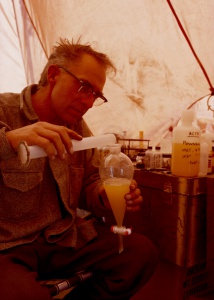

Chapter Three examines how AMEE scientists used analogy to make reality-testing at Mt. Everest applicable to the funding institutions of the American Cold War state. For public grant-funding institutions like the National Science Foundation, AMEE scientists compared Mt. Everest to other extreme environments, including the deep sea, foreign battlefields, high altitude, arctic and Antarctic outposts, and outer space. These analogous environments were emphasized because they were theaters of the Cold War, which allowed AMEE scientists to portray their teammates as proxies for submariners, soldiers, bombardiers, astronauts, and other Cold War agents. AMEE scientists approached the National Geographic Society–their major private grant-funding institution–with the same rhetoric. However, the Society’s decision had less to do with Cold War Americanism, and more to do with its response to the automation of exploration and the prevalence of big-budget science and engineering projects during the post-war era. The Society saw AMEE’s scientific endeavors on Mt. Everest as a means to link its institutional identity as a principal patron for American terrestrial exploration, and its ancillary male heroism, to NASA’s Project Mercury missions.
Now fully funded and staffed, AMEE’s travails through the Nepalese hinterland to the foot of Mt. Everest comprises the material for Chapter Four. Their arduous, four-week overland trek served to acquaint the American scientists with the cadre of Sherpas and climbers who were enrolled to serve as assistants to their data collection routines, and it sowed tension between expedition members who prioritized scientific research and those who prioritized reaching the mountain’s summit. It also gave AMEE scientists a preview of the logistical, technological, and practical difficulties associated with fieldwork in the periphery. A series of health problems, communications breakdowns, inclement weather, and other contingencies challenged the scientists’ ability to follow research protocols. These obstacles encountered during their march to Mt. Everest anticipated the destabilization of other scientific norms that occurred once the team began operations on the Everest massif.
That destabilization, and the scientists’ response to its effects, is the subject of Chapters Five, Six, and Seven. These three chapters accompany the expedition’s members as they climbed up the mountain and examine how local circumstances shaped their research programs. Over the ensuing 66 days, Dr. Will Siri, a biophysicist; Dr. Maynard M. Miller, a glaciologist, and his assistant Barry Prather; Dr. Richard Emerson, a sociologist; Dr. James Lester, a psychologist; and Barry Bishop, a glaciologist and Assistant Photo Editor at National Geographic, confronted the realities of reality-testing: instruments froze; mundane routines were always laborious, and often impossible; men and materiel scattered across the mountainside; researchers were injured; some test-subjects were incapacitated, and one perished. Under these circumstances, precise measurements became imperfect, detached objectivity dwindled as the observers consoled and sought consolation, collection methods were hampered, and their data were truncated. Because the extreme environment’s destabilizing variables emerged without warning during day-to-day operations, AMEE scientists had to quickly and cleverly formulate on-the-fly solutions that often involved enrolling untrained, illiterate Sherpas as de facto (and subsequently invisible) technicians and field assistants.[xiv] Those solutions were manifestations of an extension of masculine scientific objectivity peculiar to their extreme site: beyond “mechanical objectivity” and “trained judgment,” AMEE scientists exhibited a toughness of character analogous to the Mercury Seven’s “Right Stuff.” They had been culled for their toughness by AMEE leaders in 1962, they relied on it to see their projects through to the expedition’s end, and it became part of the theatrics that celebrated their triumphant return to the United States. Ironically, the scientific knowledge generated by Siri, Emerson, and Lester would ultimately negate the need for male “toughness” in scientific practitioners, as their science of character revealed that neither scientists nor test-subjects needed to embody the Right Stuff to succeed on Mt. Everest. Nor did they even need to be men.
Chapter Eight investigates how AMEE scientists attempted to make sense of their observations after returning to the United States in mid-1963, and how their benefactors in Washington D.C. exploited the expedition’s successes to advance Americanist ideologies. The findings from each research project are analyzed to determine the degree to which the locality of their origin is present, with special attention paid both to the scientists’ reflections on the process of conducting research in an extreme environment that defies reproduction, and to the reactions of their disciplinary communities. These reflections underline the conclusion of Science in Extremis: that the universality of scientific knowledge cannot be taken for granted by its practitioners or consumers; the extreme locale exerted seen and unseen influence over the constitution, conduct, and conclusions of the research performed within its domain. The knowledge born there was inextricably linked to the locality in which it was produced, evidenced by the scientists’ admissions. For some of AMEE’s scientists, this stunted the reception that their colleagues gave their work, while for others a closeness to “nature in the raw” heightened the authority of their results and propelled their post-expeditionary careers. Either way, Siri, Emerson, Lester, Miller, Prather, and Bishop’s personal lives were transformed by their shared experiences on Mt. Everest in 1963.
[i] Maynard M. Miller, “Sketch of the Geology of the Mahalangur Himal with Preliminary Comments on the Glaciology of Mount Everest and Some Related Problems of High Altitude Research,” (February, 1964): 2.
[ii] Steve Pyne, “Extreme Environments,” Environmental History Vol. 15 (July, 2010): 510.
[iii] David N. Livingstone, Putting Science in its Place: Geographies of Scientific Knowledge (Chicago: University of Chicago Press, 2003), xi.
[iv] Suzanne Zeller, Book Review, Isis, Vol. 96, No. 3 (September, 2005): 469.
[v] Livingstone, Putting Science in its Place, 21.
[vi] As Livingstone notes in his bibliographic essay, local contexts’ generative role in the production of scientific knowledge dates to Clifford Geertz’s Local Knowledge: Further Essays in Interpretive Anthropology (New York: Basic Books, 1983), Putting Science in its Place, 188.
[vii] Livingstone, Putting Science in its Place, 5-7. Charlotte Bigg, David Aubin, and Philipp Felsch, who co-edited a special edition of Science in Context on the history of science in mountainous spaces, understand space as a “practiced place,” as defined by Michel de Certeau in The Practice of Everyday Life (Berkeley: University of California Press, 1984), 117. Charlotte Bigg et al., “Introduction: The Laboratory of Nature — Science in the Mountains,” Science in Context, Vol. 22, No. 3 (2009): 314.
[viii] John B. West, “Human responses to extreme altitudes,” Integrative and Comparative Biology, Vol. 46, No. 1 (January, 2006): 33.
[ix] John B. West, high-altitude physiologist and leader of the 1981 American Medical Research Expedition to Everest (AMREE), considers AMREE a scientific expedition.
[x] Of Robert Merton’s scientific norms—Universalism, Communism, Disinterestedness, and Organized Skepticism—this text interrogates the third. As we shall see, the scientists’ experiences within the extreme environment both delineated their competing interests for my analysis and destabilized their ability to maintain normal disinterestedness. See Robert K. Merton, “The Normative Structure of Science,” in The Sociology of Science: Theoretical and Empirical Investigations, edited by Robert K. Merton and Norman W. Storer (Chicago: University of Chicago Press, 1973), 267.
[xi] Locality and its various implications for the historiography of science are articulated in Jouni-Matti Kuukkanen, “Sense of Localism,” History of Science, Vol. 50 (Dec., 2012): 477-500.
[xii] Actor-network theorists may find locale to be useful to help conceptualize places as actants.
[xiii] The all-male cohort of scientists and test-subjects may not have been an issue for contemporaries, however, 21st-century scientific expeditions are much more inclusive when it comes to gender. For example, see D.S. Martin, E. Gilbert-Kawai, D.Z. Levett, K. Mitchell, Bc. R. Kumar, M.G. Mythen, M.P. Grocott, “Xtreme Everest 2: unlocking the secrets of the Sherpa phenotype?” Extreme Physiology & Medicine, Vol. 2 (2013): 30.
[xiv] For more on those scientific practitioners who are often rendered invisible, see Steve Shapin, “The Invisible Technician,” American Scientist Vol. 77 (Nov.-Dec., 1989): 554.
© 2018 University of Pittsburgh Press. All rights reserved.
Like what you’ve read so far? Pre-order your copy today. Science in an Extreme Environment is also available for pre-order on Amazon, B&N.com, Indiebound, and at all major book retailers.
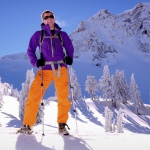

Related Interest: Clements talks with the Time to Eat Dogs podcast about the 1963 expedition.
Featured image: Courtesy of the American Alpine Club Library.

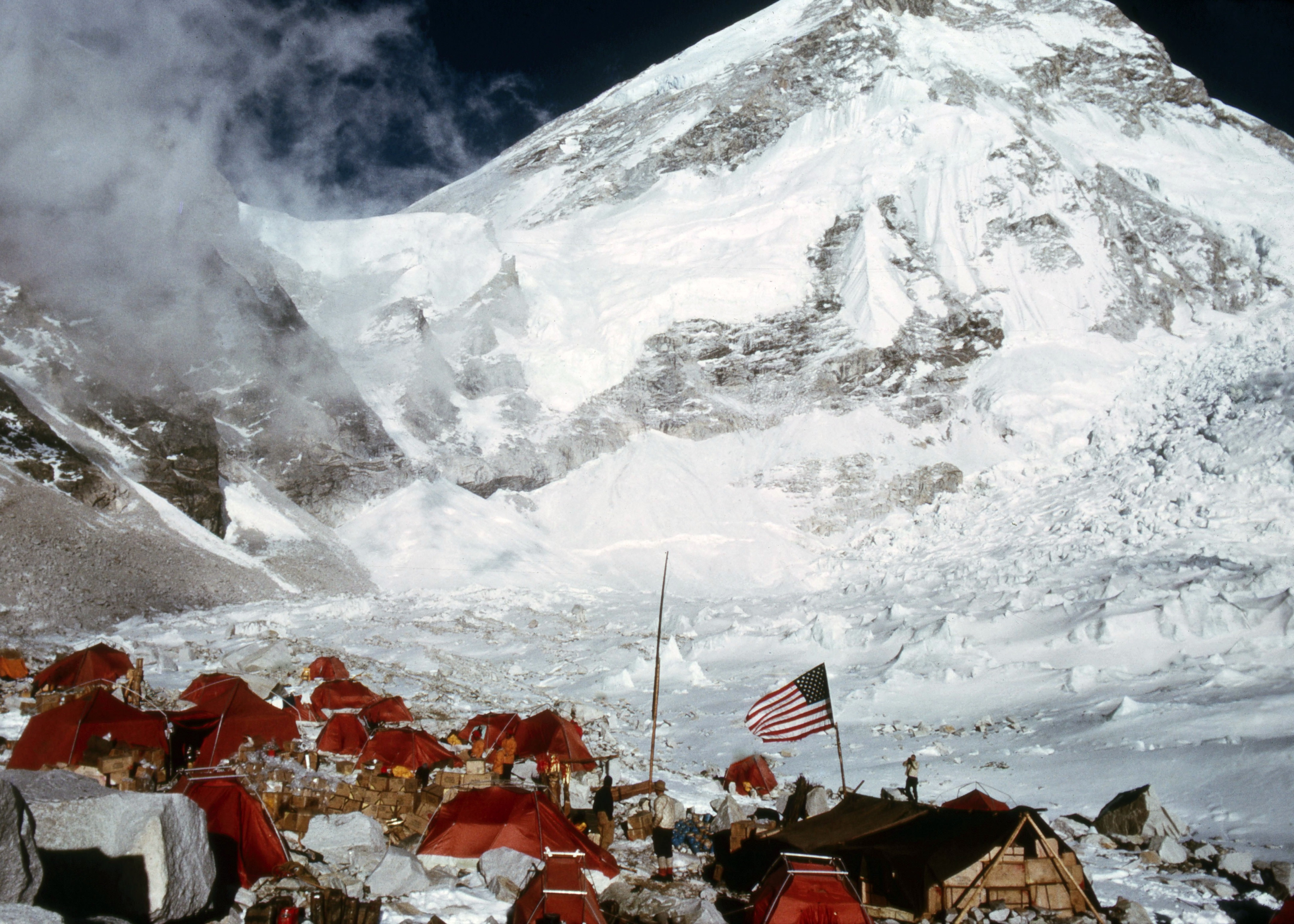
COMMENTS